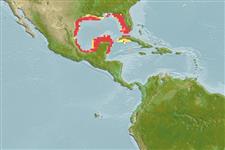Environment: milieu / climate zone / depth range / distribution range
Ecología
marino asociado a arrecife. Subtropical; 30°N - 18°N, 98°W - 81°W
Western Central Atlantic: Gulf of Mexico.
Tamaño / Peso / Age
Maturity: Lm ? range ? - ? cm
Max length : 38.0 cm TL macho / no sexado; (Ref. 7251)
Inhabits offshore water on deeper rocky reefs.
Life cycle and mating behavior
Maturities | Reproducción | Spawnings | Egg(s) | Fecundities | Larva
Robins, C.R. and G.C. Ray, 1986. A field guide to Atlantic coast fishes of North America. Houghton Mifflin Company, Boston, U.S.A. 354 p. (Ref. 7251)
IUCN Red List Status (Ref. 130435)
Threat to humans
Harmless
Human uses
Herramientas
Special reports
Download XML
Fuentes de Internet
Estimates based on models
Preferred temperature (Ref.
123201): 22.7 - 27.1, mean 24.4 °C (based on 34 cells).
Phylogenetic diversity index (Ref.
82804): PD
50 = 0.5312 [Uniqueness, from 0.5 = low to 2.0 = high].
Bayesian length-weight: a=0.00389 (0.00180 - 0.00842), b=3.12 (2.94 - 3.30), in cm total length, based on all LWR estimates for this body shape (Ref.
93245).
Nivel trófico (Ref.
69278): 3.7 ±0.6 se; based on size and trophs of closest relatives
Resiliencia (Ref.
120179): Medio, población duplicada en un tiempo mínimo de 1.4-4.4 años (Preliminary K or Fecundity.).
Fishing Vulnerability (Ref.
59153): Low to moderate vulnerability (28 of 100).
Nutrients (Ref.
124155): Calcium = 34.1 [14.5, 84.2] mg/100g; Iron = 0.52 [0.26, 1.04] mg/100g; Protein = 18.9 [17.6, 20.1] %; Omega3 = 0.129 [0.063, 0.256] g/100g; Selenium = 9.88 [4.36, 25.46] μg/100g; VitaminA = 67 [19, 246] μg/100g; Zinc = 0.86 [0.52, 1.37] mg/100g (wet weight);
